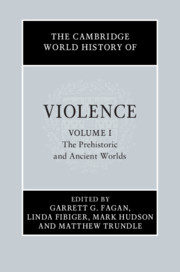Book contents
- The Cambridge World History of Violence
- The Cambridge History of Violence
- The Cambridge World History of Violence
- Copyright page
- Contents
- Figures
- Maps
- Contributors to Volume i
- General Introduction: Violence in World History
- Introduction to Volume I
- Part I The Origins of Conflict
- 1 The Origins of Warfare and Violence
- 2 Violence in Palaeolithic and Mesolithic Hunter-Gatherer Communities
- 3 Settled Lives, Unsettled Times: Neolithic Violence in Europe
- 4 Violence during the Later Stone Age of Southern Africa
- 5 Weapons, Warriors and Warfare in Bronze Age Europe
- 6 Weapons, Ritual and Warfare: Violence in Iron Age Europe
- 7 The Origins of Violence and Warfare in the Japanese Islands
- Part II Prehistoric and Ancient Warfare
- Part III Intimate and Collective Violence
- Part IV Religion, Ritual and Violence
- Part V Violence, Crime and the State
- Part VI Representations and Constructions of Violence
- Index
- References
2 - Violence in Palaeolithic and Mesolithic Hunter-Gatherer Communities
from Part I - The Origins of Conflict
Published online by Cambridge University Press: 13 March 2020
- The Cambridge World History of Violence
- The Cambridge History of Violence
- The Cambridge World History of Violence
- Copyright page
- Contents
- Figures
- Maps
- Contributors to Volume i
- General Introduction: Violence in World History
- Introduction to Volume I
- Part I The Origins of Conflict
- 1 The Origins of Warfare and Violence
- 2 Violence in Palaeolithic and Mesolithic Hunter-Gatherer Communities
- 3 Settled Lives, Unsettled Times: Neolithic Violence in Europe
- 4 Violence during the Later Stone Age of Southern Africa
- 5 Weapons, Warriors and Warfare in Bronze Age Europe
- 6 Weapons, Ritual and Warfare: Violence in Iron Age Europe
- 7 The Origins of Violence and Warfare in the Japanese Islands
- Part II Prehistoric and Ancient Warfare
- Part III Intimate and Collective Violence
- Part IV Religion, Ritual and Violence
- Part V Violence, Crime and the State
- Part VI Representations and Constructions of Violence
- Index
- References
Summary
This chapter looks at whether violence within and between groups played an important role in the Palaeolithic and Mesolithic periods. The evidence is based on osteological information, which is limited by preservation and the incomplete osteological record. With regards identified traumatic lesions, it seems problematic to distinguish between accidents and interpersonal violence. The first clear evidence of interpersonal and lethal violence on a large scale is from the Upper and Late Palaeolithic. Current data shows that cases of violent behaviour are evident through the Palaeolithic and Mesolithic periods, some of which gives evidence of group conflict. However, violent behaviour does not occur more often in later or earlier times of the Palaeolithic. Besides the evidence for violent interactions there is also sporadic evidence for treatment and care of trauma and other injuries throughout the Palaeolithic and Mesolithic. The increase in cases of interpersonal violence from the Mesolithic period is most likely related to better preservation and the much higher number of burials and more complete skeletons. Violence is present not only in recent hunter-gatherers and nomadic groups, but also among Palaeolithic and Mesolithic hunter-gatherers.
- Type
- Chapter
- Information
- The Cambridge World History of Violence , pp. 58 - 78Publisher: Cambridge University PressPrint publication year: 2020
References
Bibliographic Essay
- 5
- Cited by



